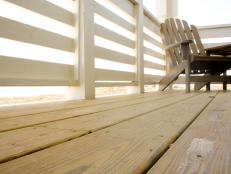Making Deck Repairs

Maintaining your wood deck may also require repairing or replacing loose or broken boards that can make your deck unsafe to walk on. Surface boards as well as joists can rot, so inspect the deck at least once a year for signs of rot. Even a pressure-treated or preserved-wood deck can suffer loose screws or boards. It's best to hire a professional to replace any boards that are twisting, lifting or rotted.
To replace rotted or broken boards, remove the screws and use the damaged board as a template to cut a new board of the same material. Once you remove the rotted board, check the joists underneath to be sure they are free of rot.
Contact a professional if you see any signs of rot, as this is a bigger job and will require repairing or replacing the joists. If the rot is localized to a specific area of the joist, a "sister" board can be attached to the joist to support the surface boards instead of replacing the entire joist. A professional will be able to determine if this is the best course of repair. To replace the old board with a new one, drill pilot holes into the board where it should attach to the joists, then screw in the new board to the joists.
Matching the Finish Stain
You'll want to match the finish stain of the replaced board to the existing boards. Use the same type of stain originally used on the deck. You can pre-stain the board before installing it, or you can stain it after you replace it.
While you may be staining just the newly replaced deck board, Decks.com advises that you stain your entire deck once a year starting soon after it's installed. Some pressure-treated wood requires a 30- to 90-day drying-out period. Ask your installer how long you should wait before staining your pressure-treated wood deck.
Stains come in many different colors, from light to dark. You can match the color of the deck to the siding on your house or use a complementary color to the hue of your home. Stains come in transparent types that allow the grain of the wood to show through, and there are semi-transparent finishes that color the wood but still allow the grain to show through.
For the most color, solid stains completely hide the grain of the wood. Good choices come from Behr and Woodsman. The choice is up to you.
For best results, you should apply stain to a clean, dry deck. Using a synthetic brush or paint roller, apply even strokes following the grain of the wood. Start with the railing so you can clean up any drips before tackling the floor of the deck. Let the newly stained deck, or replaced board, dry for at least three hours or more before walking on it.
After the deck is stained, you should apply a topical sealer, which will help keep out moisture. Some stains have a built-in sealer, allowing you to skip this step, but ask at the store which one is right for your deck. You apply the topical coat the same way you would apply a deck stain using a synthetic brush or roller.




































